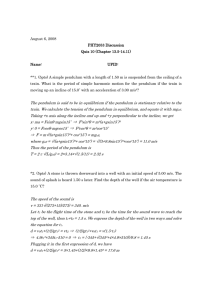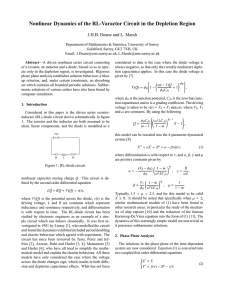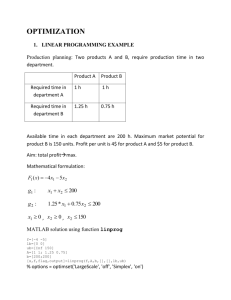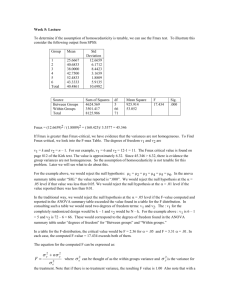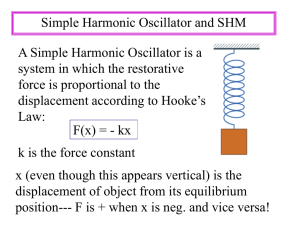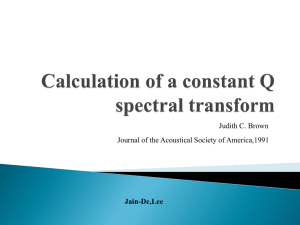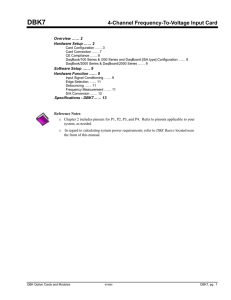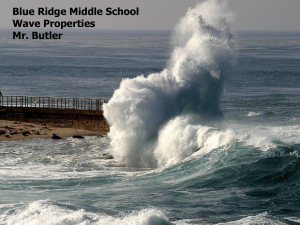Physics Problems: Oscillations and Waves Solutions
advertisement
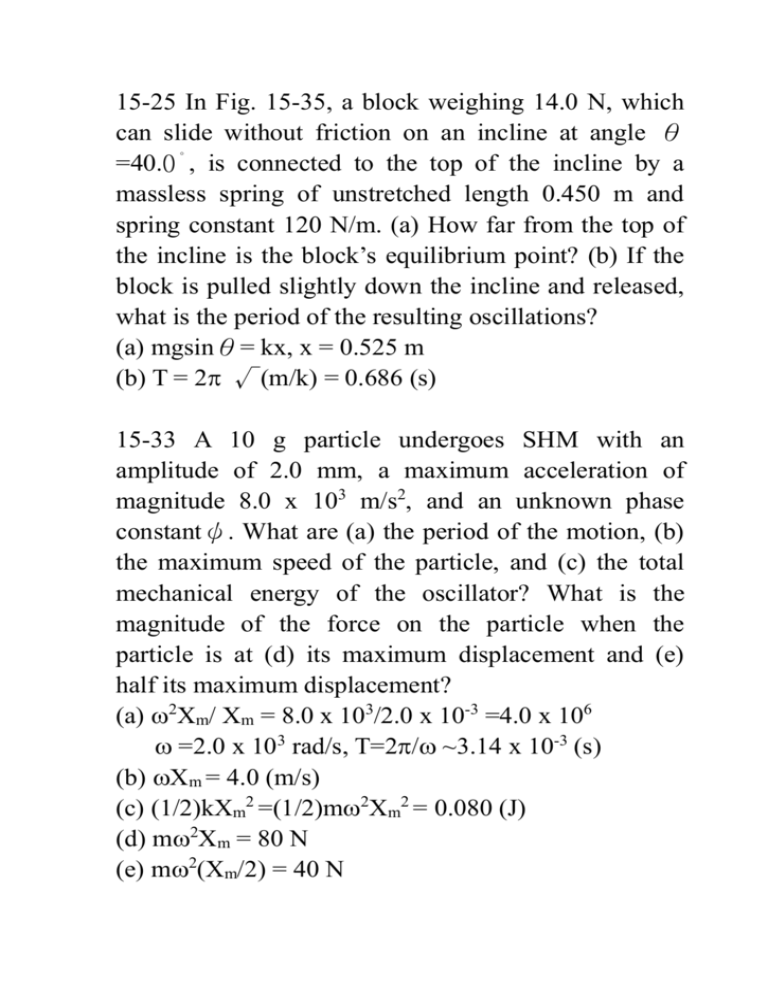
15-25 In Fig. 15-35, a block weighing 14.0 N, which can slide without friction on an incline at angle θ 。 =40.0 , is connected to the top of the incline by a massless spring of unstretched length 0.450 m and spring constant 120 N/m. (a) How far from the top of the incline is the block’s equilibrium point? (b) If the block is pulled slightly down the incline and released, what is the period of the resulting oscillations? (a) mgsinθ= kx, x = 0.525 m (b) T = 2 √(m/k) = 0.686 (s) 15-33 A 10 g particle undergoes SHM with an amplitude of 2.0 mm, a maximum acceleration of magnitude 8.0 x 103 m/s2, and an unknown phase constantψ. What are (a) the period of the motion, (b) the maximum speed of the particle, and (c) the total mechanical energy of the oscillator? What is the magnitude of the force on the particle when the particle is at (d) its maximum displacement and (e) half its maximum displacement? (a) 2Xm/ Xm = 8.0 x 103/2.0 x 10-3 =4.0 x 106 =2.0 x 103 rad/s, T=2/~3.14 x 10-3 (s) (b) Xm = 4.0 (m/s) (c) (1/2)kXm2 =(1/2)m2Xm2 = 0.080 (J) (d) m2Xm = 80 N (e) m2(Xm/2) = 40 N 15-35 A block of mass M = 5.4 kg at rest on a horizontal frictionless table, is attached to a rigid support by a spring of constant k = 6000 N/m. A bullet of mass m = 9.5 g and velocity v of magnitude 630 m/s strikes and embedded in the block. Assuming the compression of the spring is negligible until the bullet is embedded, determine (a) the speed of the block immediately after the collision and (b) the amplitude of the resulting simple harmonic motion (SHM). (a) Completely inelastic collision (9.5 x 10-3) (630) = (5.4 + 9.5 x 10-3) v v=1.1 (m/s) (b) (1/2) (5.4 + 9.5 x 10-3)(1.1)2 = (1/2)(6000) Xm2 Xm=3.3 x 10-2 (m) 16-29 Use the wave equation to find the speed of a wave given by y(x, t) = (2.00 mm) [(20 m-1)x - (4.0 s-1)t]0.5 (20 m-1)x – (4.0 s-1)t = a constant (20 m-1)dx – (4.0 s-1)dt =0 dx/dt = (4.0 s-1)/(20 m-1) = 0.20 (m/s) 16-35 Two sinusoidal waves of the same frequency travel in the same direction along a string. If ym1 = 3.0 cm, ym2 = 4.0 cm, ψ1 = 0 , and ψ2 = /2 rad, what is the amplitude of the resultant wave? √[(3.0)2 + (4.0)2] = 5.0 (cm), phase constant = 53。 16-39 These two waves travel along the same string: y1(x,t) = (4.60 mm)sin(2x - 400t) y2(x,t) = (5.60 mm)sin(2x - 400t +0.80 rad) What are (a) the amplitude and (b) the phase angle (relative to wave 1) of the resultant wave? (c) If a third wave of amplitude 5.00 mm is also to be sent along the string in the same direction as the first two waves, what should be its phase angle in order to maximize the amplitude of the new resultant wave? (a) x component: 4.60 + 5.60cos(0.80) y component: 5.60 sin(0.80) 3.29 mm (b) 1.55 rad (c) 1.55 rad 17-21 Two loudspeakers are located 3.35 m apart on an out-door stage. A listener is 18.3 m from one and 19.5 m from the other. During the sound check, a signal generator drives two speakers in phase with the same amplitude and frequency. The transmitted frequency is swept through the audible range (20 Hz to 20 kHz). (a) What is the lowest frequency fmin,1 that gives minimum signal (destructive interference) at the listener’s location? By what number must fmin,1 be multiplied to get (b) the second lowest frequency fmin,2 that gives minimum signal and (c) the third lowest frequency fmin,3 that gives minimum signal? (d) What is the lowest frequency fmax,1 that gives maximum signal (constructive interference) at the listener’s location? By what number must fmax,1 be multiplied to get (e) the second lowest frequency fmax,2 that gives maximum signal and (f) the third lowest frequency fmax,3 that gives maximum signal? L/ = n-(1/2), n=1, 2, 3,….. L = 19.5 -18.3 = 1.2 (m) v=343 m/s, v=f fmin,n = (2n-1)v/[2L] = (n-1/2)(286 Hz) (a) n=1, fmin,1 = 143 Hz (b) fmin,2 = 3fmin,1 (c) fmin,2 = 5fmin,1 (d) fmax,n = nv/L=n(286 Hz), n=1, 2, 3……. fmax,1 =286 Hz (e) fmax,2 = 2fmax,1 (f) fmax,3 = 3fmax,1 17-45 In Fig. 17-41, S is a small loudspeaker driven by an audio oscillator with a frequency that is varied from 1000 Hz to 2000 Hz, and D is a cylindrical pipe with two open ends and a length of 45.7 cm. The speed of sound in the air-filled pipe is 344 m/s. (a) At how many frequencies does the sound from the loudspeaker set up resonance in the pipe? What are the (b) lowest and (c) second lowest frequencies at which resonance occurs? (a) =2L/n f=n(344)/(2)(0.457 m) =376.4n Hz 3, 4 and 5 (b) 3 x 376.4=1129 Hz (c) 4 x 376.4=1506 Hz 17-57 A whistle of frequency 540 Hz moves in a circle of radius 60.0 cm at an angular speed of 15.0 rad/s. What are the lowest and (b) highest frequencies heard by a listener a long distance away, at rest with respect to the center of the circle? v=343 m/s vs= rm/s (a) lowest frequency f’ = f[v/(v+ vs)] = 526 Hz (b) highest frequency f’ = f[v/(v- vs)] = 555 Hz
